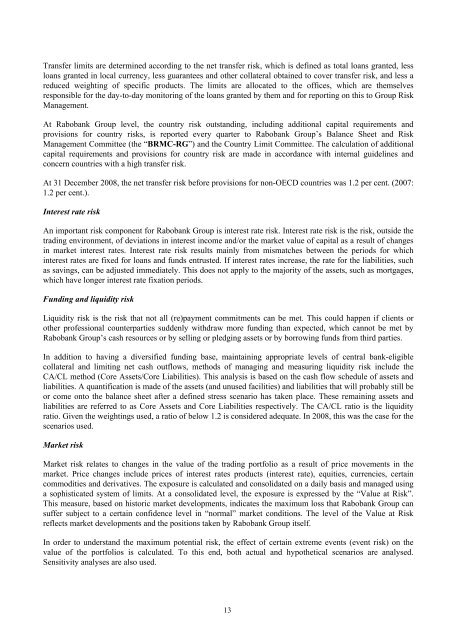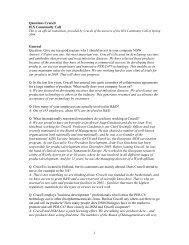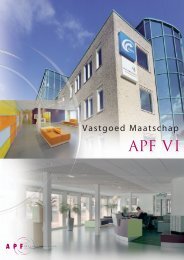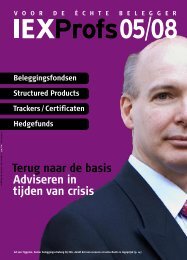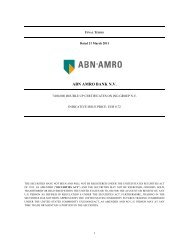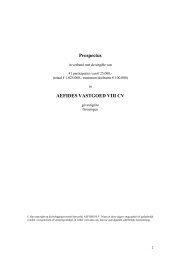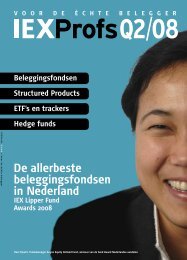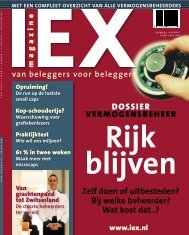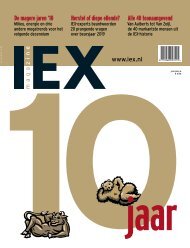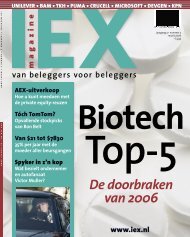Dit prospectus is gemaakt voor de uitgifte van dit product en ... - Iex
Dit prospectus is gemaakt voor de uitgifte van dit product en ... - Iex
Dit prospectus is gemaakt voor de uitgifte van dit product en ... - Iex
Create successful ePaper yourself
Turn your PDF publications into a flip-book with our unique Google optimized e-Paper software.
Transfer limits are <strong>de</strong>termined according to the net transfer r<strong>is</strong>k, which <strong>is</strong> <strong>de</strong>fined as total loans granted, lessloans granted in local curr<strong>en</strong>cy, less guarantees and other collateral obtained to cover transfer r<strong>is</strong>k, and less areduced weighting of specific <strong>product</strong>s. The limits are allocated to the offices, which are themselvesresponsible for the day-to-day monitoring of the loans granted by them and for reporting on th<strong>is</strong> to Group R<strong>is</strong>kManagem<strong>en</strong>t.At Rabobank Group level, the country r<strong>is</strong>k outstanding, including ad<strong>dit</strong>ional capital requirem<strong>en</strong>ts andprov<strong>is</strong>ions for country r<strong>is</strong>ks, <strong>is</strong> reported every quarter to Rabobank Group’s Balance Sheet and R<strong>is</strong>kManagem<strong>en</strong>t Committee (the “BRMC-RG”) and the Country Limit Committee. The calculation of ad<strong>dit</strong>ionalcapital requirem<strong>en</strong>ts and prov<strong>is</strong>ions for country r<strong>is</strong>k are ma<strong>de</strong> in accordance with internal gui<strong>de</strong>lines andconcern countries with a high transfer r<strong>is</strong>k.At 31 December 2008, the net transfer r<strong>is</strong>k before prov<strong>is</strong>ions for non-OECD countries was 1.2 per c<strong>en</strong>t. (2007:1.2 per c<strong>en</strong>t.).Interest rate r<strong>is</strong>kAn important r<strong>is</strong>k compon<strong>en</strong>t for Rabobank Group <strong>is</strong> interest rate r<strong>is</strong>k. Interest rate r<strong>is</strong>k <strong>is</strong> the r<strong>is</strong>k, outsi<strong>de</strong> thetrading <strong>en</strong>vironm<strong>en</strong>t, of <strong>de</strong>viations in interest income and/or the market value of capital as a result of changesin market interest rates. Interest rate r<strong>is</strong>k results mainly from m<strong>is</strong>matches betwe<strong>en</strong> the periods for whichinterest rates are fixed for loans and funds <strong>en</strong>trusted. If interest rates increase, the rate for the liabilities, suchas savings, can be adjusted immediately. Th<strong>is</strong> does not apply to the majority of the assets, such as mortgages,which have longer interest rate fixation periods.Funding and liqui<strong>dit</strong>y r<strong>is</strong>kLiqui<strong>dit</strong>y r<strong>is</strong>k <strong>is</strong> the r<strong>is</strong>k that not all (re)paym<strong>en</strong>t commitm<strong>en</strong>ts can be met. Th<strong>is</strong> could happ<strong>en</strong> if cli<strong>en</strong>ts orother professional counterparties sud<strong>de</strong>nly withdraw more funding than expected, which cannot be met byRabobank Group’s cash resources or by selling or pledging assets or by borrowing funds from third parties.In ad<strong>dit</strong>ion to having a diversified funding base, maintaining appropriate levels of c<strong>en</strong>tral bank-eligiblecollateral and limiting net cash outflows, methods of managing and measuring liqui<strong>dit</strong>y r<strong>is</strong>k inclu<strong>de</strong> theCA/CL method (Core Assets/Core Liabilities). Th<strong>is</strong> analys<strong>is</strong> <strong>is</strong> based on the cash flow schedule of assets andliabilities. A quantification <strong>is</strong> ma<strong>de</strong> of the assets (and unused facilities) and liabilities that will probably still beor come onto the balance sheet after a <strong>de</strong>fined stress sc<strong>en</strong>ario has tak<strong>en</strong> place. These remaining assets andliabilities are referred to as Core Assets and Core Liabilities respectively. The CA/CL ratio <strong>is</strong> the liqui<strong>dit</strong>yratio. Giv<strong>en</strong> the weightings used, a ratio of below 1.2 <strong>is</strong> consi<strong>de</strong>red a<strong>de</strong>quate. In 2008, th<strong>is</strong> was the case for thesc<strong>en</strong>arios used.Market r<strong>is</strong>kMarket r<strong>is</strong>k relates to changes in the value of the trading portfolio as a result of price movem<strong>en</strong>ts in themarket. Price changes inclu<strong>de</strong> prices of interest rates <strong>product</strong>s (interest rate), equities, curr<strong>en</strong>cies, certaincommo<strong>dit</strong>ies and <strong>de</strong>rivatives. The exposure <strong>is</strong> calculated and consolidated on a daily bas<strong>is</strong> and managed usinga soph<strong>is</strong>ticated system of limits. At a consolidated level, the exposure <strong>is</strong> expressed by the “Value at R<strong>is</strong>k”.Th<strong>is</strong> measure, based on h<strong>is</strong>toric market <strong>de</strong>velopm<strong>en</strong>ts, indicates the maximum loss that Rabobank Group cansuffer subject to a certain confi<strong>de</strong>nce level in “normal” market con<strong>dit</strong>ions. The level of the Value at R<strong>is</strong>kreflects market <strong>de</strong>velopm<strong>en</strong>ts and the positions tak<strong>en</strong> by Rabobank Group itself.In or<strong>de</strong>r to un<strong>de</strong>rstand the maximum pot<strong>en</strong>tial r<strong>is</strong>k, the effect of certain extreme ev<strong>en</strong>ts (ev<strong>en</strong>t r<strong>is</strong>k) on thevalue of the portfolios <strong>is</strong> calculated. To th<strong>is</strong> <strong>en</strong>d, both actual and hypothetical sc<strong>en</strong>arios are analysed.S<strong>en</strong>sitivity analyses are also used.13


